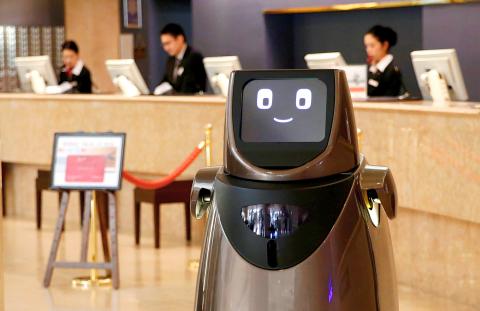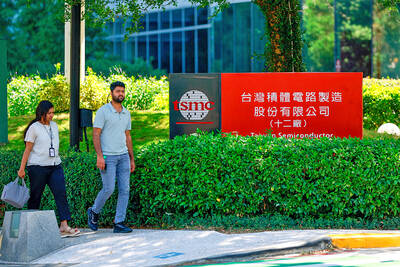Welcoming a robot into her family was never Maxine Duncan’s idea of a support aide in her older years.
However, this winter, she and her partner, Herbert Yarbrough, signed up to test a telepresence robot in their retirement community in Walnut Creek, California. Their new pal has a screen for a head and scuttles around on wheels.
The lure was being able to connect more easily with their families via video calls.

Photo: Reuters
The couple were immediately smitten. They have named the robot Jimmy.
“It’s an easy name to remember,” said Duncan, 86, a former real-estate broker.
Yarbrough, 89, takes the robot on the elevator to pick up breakfast downstairs.
“We want to keep up on technology,” said Duncan, who covets a self-driving car. “A lot of older people are isolated from people and ideas. Now we’re on the cutting edge.”
Early adopters like Duncan are on the front lines of testing new technologies that some experts say are set to upend a few of the constants of retirement.
Eager not to be left behind, retirement communities are increasingly serving as testing grounds that vet winners and losers.
Some simple tools that can help older adults are already mass-market consumer items, like Amazon.com Inc’s personal assistant, Alexa. Other inventions, such as virtual reality (VR) technologies and robotic limbs, are still in their early days, but could soon provide more freedom, resources and constant care to retirees.
Some technologists see the most promise in the social dimensions.
For too long, technology has been chasing problems rather than trying to delight human beings, said Joseph Coughlin, director of the AgeLab at the Massachusetts Institute of Technology.
“Where are the devices that help us learn and expand our horizons?” he asked.
Virtual reality, for example, can entertain, educate and engage us, he said.
“It’s for young and old alike,” Coughlin said. “And it’s enjoyed, not needed. That’s the high ground.”
These devices will especially help augment the adult child’s caregiver role, he added.
Thuc Vu, co-founder of OhmniLabs Inc, helped invent the robot Ohmni that is now Duncan and Yarbrough’s companion.
Vu, who has a doctorate in computer science from Stanford University, sees consumer robotics as the next big technology wave.
“There’s a huge senior population, but isolation and loneliness is still common,” he said. “And we’re also running out of caregivers, since most of them are getting older.”
The OhmniLabs robot was designed with the techno-averse in mind and requires limited computer knowledge. It is connected to Wi-Fi and operated remotely. In its next iteration, the company is working on training the robot to pick up objects.
“In five years, it will be able to wash dishes, do laundry and clean the house,” Vu said.
This year, OhmniLabs robots is to be offered by a consumer health firm, Home Care Assistance Corp, to retirement communities and people aging in place.
The yearly cost is about 20 percent of the cost, on average, of hiring full-time caregivers, Home Care Assistance chief executive Lily Sarafan said.
“In five to seven years, caregiving will shift,” she said. “And a lot of home automation will become more mainstream.”
Digital health means more attention to senior care, said Sarafan, who is an active tech investor and a mentor at StartX, a business incubator at Stanford University.
“Otherwise, aging is a huge challenge,” she added.
Brookdale Senior Living, which has more than 1,000 residential communities, is also testing new technology.
Its Entrepreneur in Residence program invites start-ups into its communities for short stays to test new gadgets. They include “smart” medication devices, virtual reality and family connection apps.
Older adults at Brookdale are eager to offer feedback, director of strategy and innovation Andrew Smith said.
Entrepreneurs also get firsthand experiences with an aging population that has to adapt to their ideas.
“Technology will change the way people age in America,” Smith said.
Some devices miss their mark. Brookdale residents tested a body dryer, which is widely used at amusement parks to dry people after a ride.
“No one would come near it,” he said.
Changing ideas about aging are also affecting how products are branded, said Stephen Johnston, cofounder of the technology accelerator Aging2.0.
However, some companies still have a learning curve, such as one start-up that used the word “grandparent” in its name.
“But not every older person is a grandparent,” Johnston said.

RECYCLE: Taiwan would aid manufacturers in refining rare earths from discarded appliances, which would fit the nation’s circular economy goals, minister Kung said Taiwan would work with the US and Japan on a proposed cooperation initiative in response to Beijing’s newly announced rare earth export curbs, Minister of Economic Affairs Kung Ming-hsin (龔明鑫) said yesterday. China last week announced new restrictions requiring companies to obtain export licenses if their products contain more than 0.1 percent of Chinese-origin rare earths by value. US Secretary of the Treasury Scott Bessent on Wednesday responded by saying that Beijing was “unreliable” in its rare earths exports, adding that the US would “neither be commanded, nor controlled” by China, several media outlets reported. Japanese Minister of Finance Katsunobu Kato yesterday also

Taiwan’s rapidly aging population is fueling a sharp increase in homes occupied solely by elderly people, a trend that is reshaping the nation’s housing market and social fabric, real-estate brokers said yesterday. About 850,000 residences were occupied by elderly people in the first quarter, including 655,000 that housed only one resident, the Ministry of the Interior said. The figures have nearly doubled from a decade earlier, Great Home Realty Co (大家房屋) said, as people aged 65 and older now make up 20.8 percent of the population. “The so-called silver tsunami represents more than just a demographic shift — it could fundamentally redefine the

China Airlines Ltd (CAL, 中華航空) said it expects peak season effects in the fourth quarter to continue to boost demand for passenger flights and cargo services, after reporting its second-highest-ever September sales on Monday. The carrier said it posted NT$15.88 billion (US$517 million) in consolidated sales last month, trailing only September last year’s NT$16.01 billion. Last month, CAL generated NT$8.77 billion from its passenger flights and NT$5.37 billion from cargo services, it said. In the first nine months of this year, the carrier posted NT$154.93 billion in cumulative sales, up 2.62 percent from a year earlier, marking the second-highest level for the January-September

‘DRAMATIC AND POSITIVE’: AI growth would be better than it previously forecast and would stay robust even if the Chinese market became inaccessible for customers, it said Taiwan Semiconductor Manufacturing Co (TSMC, 台積電) yesterday raised its full-year revenue growth outlook after posting record profit for last quarter, despite growing market concern about an artificial intelligence (AI) bubble. The company said it expects revenue to expand about 35 percent year-on-year, driven mainly by faster-than-expected demand for leading-edge chips for AI applications. The world’s biggest contract chipmaker in July projected that revenue this year would expand about 30 percent in US dollar terms. The company also slightly hiked its capital expenditure for this year to US$40 billion to US$42 billion, compared with US$38 billion to US$42 billion it set previously. “AI demand actually